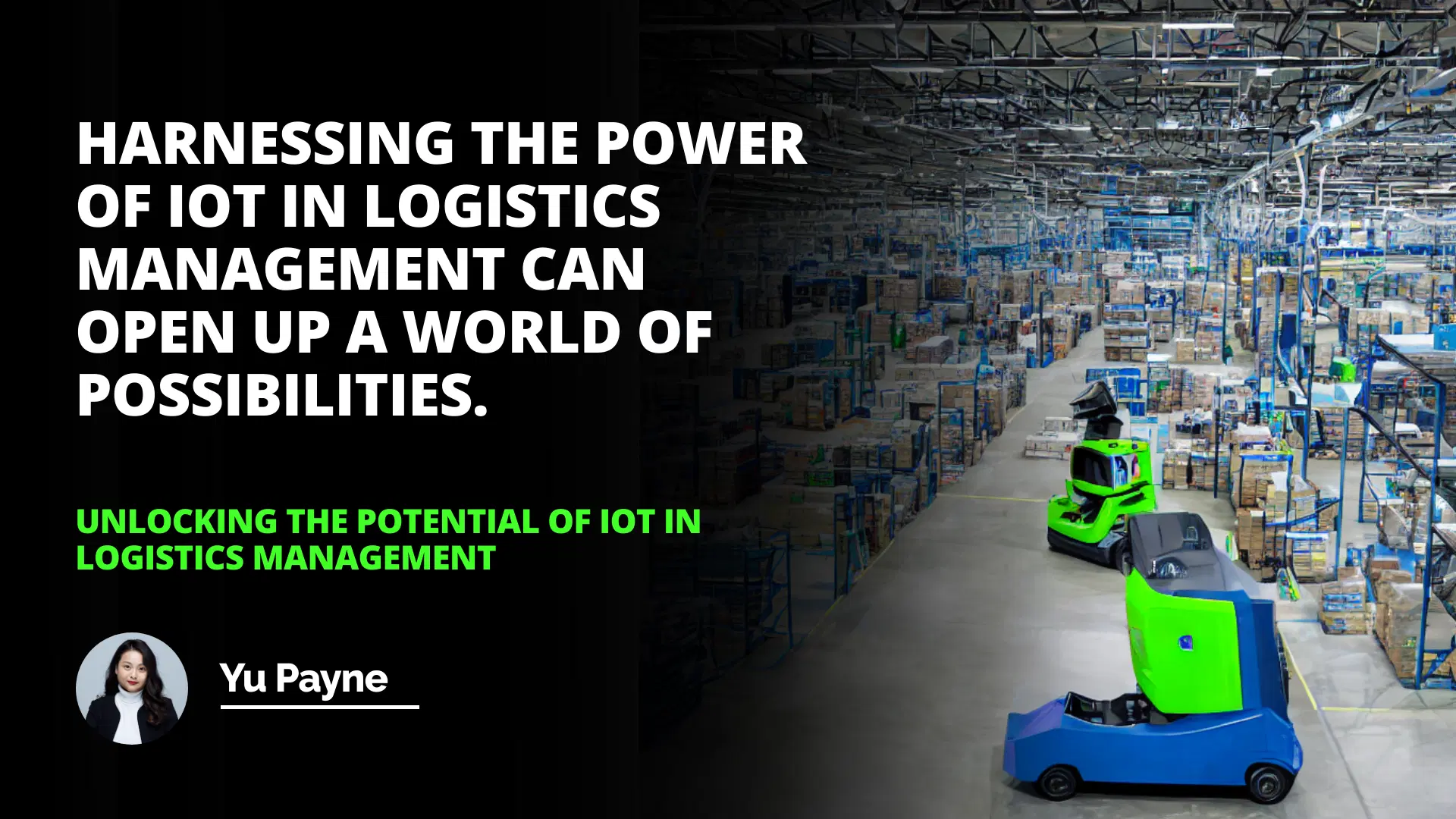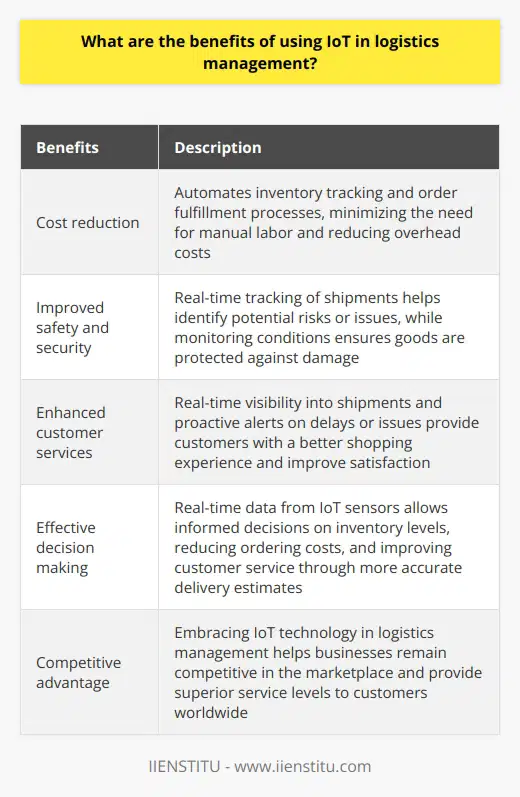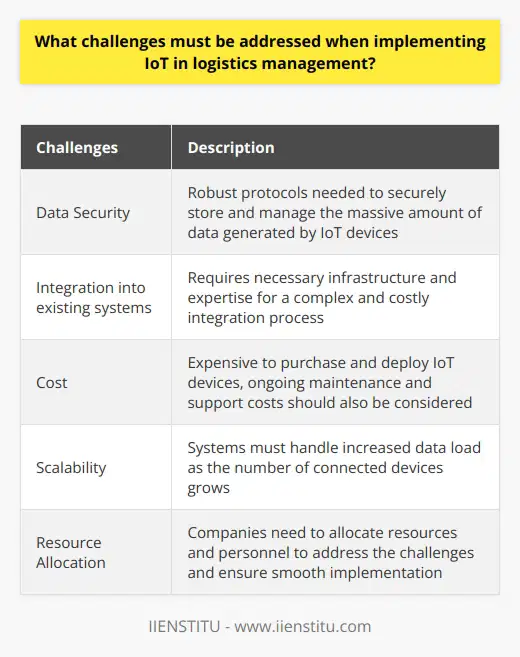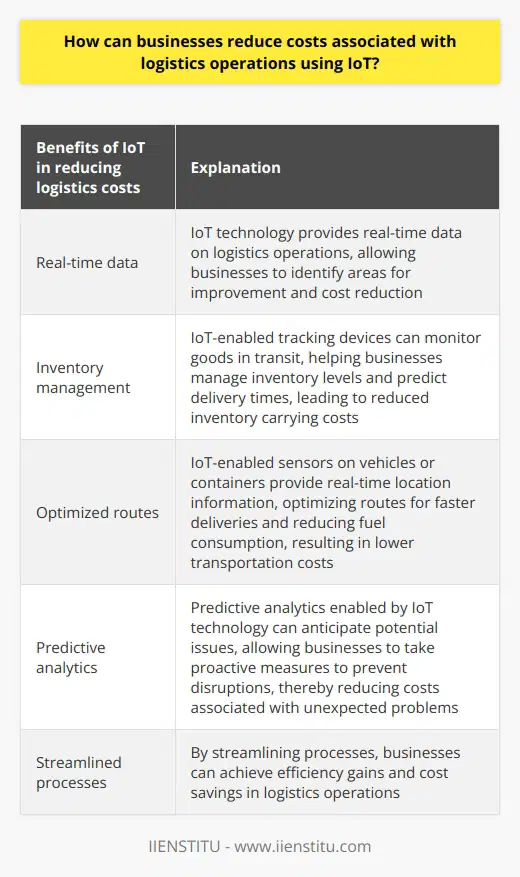
Introduction to IoT and Logistics Management
Benefits of IoT in Logistics Management
Challenges of Implementing IoT in Logistics Management
Case Studies of Successful IoT Implementation in Logistics Management
Future Outlook for IoT in Logistics Management
Related Course: Logistics Certification Online
The Internet of Things (IoT) has opened up a new world of possibilities for businesses worldwide. It has revolutionized how businesses function and operate, with significant advantages for those who have embraced the technology. Logistics management, in particular, has greatly benefited from using IoT.
Logistics management is the process of planning, controlling, and executing the efficient transportation and storage of goods and services. IoT has enabled businesses to more effectively and efficiently manage their logistics operations, resulting in increased efficiency and cost savings.
Benefits of IoT in Logistics Management
IoT in logistics management has enabled businesses to gain greater visibility and control over their supply chain operations. This improved visibility and control allow businesses to predict customer demands better, anticipate supply chain disruptions, and optimize inventory levels. IoT also helps to reduce costs associated with logistics operations by reducing the need for manual processes and improving the accuracy of data collection.
Additionally, IoT-enabled devices can be used to track shipments and monitor the performance of vehicles, leading to improved customer satisfaction and reducing the risk of lost or damaged goods.
Challenges of Implementing IoT in Logistics Management
Although IoT in logistics management has many advantages, several challenges must be addressed. One of the primary challenges is the cost associated with implementing IoT technology. Another challenge is the need for experienced professionals knowledgeable about the technology and can implement it effectively.
Achieving Reliable Delivery Performance in Logistics Management
Navigating the Science of Batch Order Picking in Supply Chain Operations
Adapting to the Future with Smart Logistics: A Comprehensive Overview
Optimal Inventory: Unlocking Decisions for Higher Performance
Additionally, there may be a need for more standardization across different IoT systems, making integrating them into existing operations difficult. Finally, security is a significant concern regarding any IoT system, as the data collected and transmitted is susceptible.
Optimizing Logistics Management Production Distribution Decisions
Effective Procurement Management Strategies For Supply Chain Success
The History And İmpact Of Logistics On The Modern Supply Chain
Case Studies of Successful IoT Implementation in Logistics Management
Despite the challenges, there have been many success stories of businesses that have embraced the use of IoT in logistics management. Amazon, for example, has used IoT-enabled robots to automate their warehouses, leading to increased efficiency and cost savings.
UPS has also implemented an IoT-based system for tracking and monitoring the performance of their delivery vehicles. Moreover, DHL has used IoT-connected devices to monitor temperature and humidity levels in their warehouses, helping to ensure that goods are stored correctly and safely.
Future Outlook for IoT in Logistics Management
IoT in logistics management is only expected to grow in the coming years. With the continued development of IoT technology, businesses can take advantage of new capabilities to further improve their operations. Additionally, the cost of implementing IoT systems is expected to decrease, making them more accessible to businesses of all sizes. As a result, more businesses will likely embrace the technology and take advantage of its many benefits.
Conclusion
IoT has significantly changed the way businesses manage their logistics operations. It has enabled greater visibility and control over the supply chain, allowing businesses to reduce costs and optimize their operations. However, there are still challenges associated with implementing IoT systems, including cost and the need for standardization. Nevertheless, many businesses have successfully implemented IoT in their operations, and the technology is only expected to become more prevalent.
Harnessing the power of IoT in logistics management can open up a world of possibilities.

Frequently Asked Questions
What are the benefits of using IoT in logistics management?
The Internet of Things (IoT) is a collection of connected physical devices, vehicles, home appliances, and other items embedded with electronics, software, sensors, and network connectivity that enables these objects to collect and exchange data. The use of IoT in logistics management offers many advantages to both customers and businesses.
Firstly, IoT in logistics management can help businesses reduce costs. By connecting various devices within the supply chain, companies can streamline their operations by automating inventory tracking and order fulfillment processes. This helps to reduce the need for manual labor, thus leading to lower overhead costs for business owners. Additionally, with real-time data from IoT sensors, businesses can make informed decisions on their inventory levels, leading to reduced ordering costs and improved customer service through more accurate delivery estimates.
Secondly, IoT can also improve safety and security in logistics management systems. For example, sensors embedded in goods or containers allow companies to track shipments in real-time, which helps them identify potential risks or issues before they become problems. Additionally, by monitoring conditions such as temperature and humidity during transportation, goods are better protected against damage, ensuring that packages reach their destination intact.
Finally, IoT in logistics management also allows customers to access better services when placing orders online or tracking their shipments. Real-time visibility into each shipment’s location and proactive alerts on delays or issues provide customers with a better experience while shopping online or waiting for deliveries at home. These features also enable companies to build stronger relationships with customers by providing reliable information about their orders throughout the delivery process, thus increasing customer satisfaction.
All these benefits illustrate why it is essential for businesses today to embrace the use of IoT technology when managing their logistics operations if they want to remain competitive within the marketplace while providing superior service levels for customers worldwide.

What challenges must be addressed when implementing IoT in logistics management?
The Internet of Things (IoT) is revolutionizing the way logistics management is carried out. As a result, businesses can gain efficiencies, reduce costs, and improve customer service by connecting physical assets and devices with digital data. However, several challenges must be addressed when implementing IoT in logistics management.
The first challenge is data security. IoT devices generate a massive amount of data, and this data must be securely stored and managed to ensure that it is not misused or accessed by unauthorized parties. Companies must have robust data security protocols to protect their data and ensure it is not vulnerable to malicious actors.
Another challenge is the integration of IoT devices into existing systems. Companies must have the necessary infrastructure and expertise to integrate IoT devices into existing systems. This can be a complex and costly process, and companies must have the necessary resources and personnel to ensure this process goes smoothly.
In addition, companies must also consider the cost of implementing IoT in logistics management. IoT devices can be expensive to purchase and deploy, and companies must ensure they have the necessary funds to cover the cost of implementation. There is also the cost of ongoing maintenance and support, which must be considered when budgeting for an IoT project.
Finally, companies must consider the scalability of their IoT solution. As connected devices grow, companies must ensure their systems can scale up to accommodate the increased data load. This requires companies to ensure they have the necessary infrastructure and resources to support the growth of their IoT solution.
In conclusion, implementing IoT in logistics management is complex and costly. Companies must be aware of the challenges associated with IoT implementation and have the necessary resources and personnel to ensure the process goes smoothly. By addressing these challenges, companies can ensure that they can take full advantage of the benefits of IoT in logistics management.

How can businesses reduce costs associated with logistics operations using IoT?
In today's competitive business environment, cost reduction is paramount for businesses to remain competitive and profitable. Logistics operations constitute a significant component of any business's overhead costs, and organizations must find ways to reduce these costs to remain competitive. One way businesses can reduce logistics operations costs is through the use of Internet of Things (IoT) technology. IoT can streamline processes, increase visibility and transparency, improve asset utilization, reduce inventory levels, and enable predictive maintenance—all of which can lead to significant cost savings.
IoT technology allows businesses to collect real-time data on their logistics operations, which enables them to identify areas where they can improve efficiency or reduce costs. By utilizing sensors and other hardware devices in the supply chain network, organizations can gain greater visibility into their logistics operations, which allows them to make timely decisions that impact their bottom line. For example, businesses can leverage IoT-enabled tracking devices on goods in transit, enabling them to monitor better and manage inventory levels and predict delivery times more accurately, resulting in reduced inventory carrying costs. IoT-enabled sensors on vehicles or containers also allow organizations to track location information in real-time that, helps optimize routes for faster deliveries while reducing fuel consumption—ultimately leading to lower transportation costs.
Predictive analytics enabled by IoT technology is also an excellent way for businesses to save money on logistics operations by anticipating problems before they occur rather than reacting after something has gone wrong. For example, predictive analytics allows organizations to detect potential issues such as equipment malfunction or delays due to occurring weather conditions before they happen, enabling them to take proactive measures such as scheduling preventive maintenance or rerouting shipments accordingly—ultimately reducing the overall cost associated with these incidents. This type of proactive approach not only saves time but also helps organizations avoid costly incidents further down the road.
In conclusion, there are several ways that businesses can leverage Internet of Things (IoT) technology in order to reduce costs associated with their logistics operations, including streamlining processes, increasing visibility and transparency into supply chain networks, improving asset utilization, reducing inventory levels; and enabling predictive maintenance capabilities through data analysis—all leading up significant cost savings over time.



